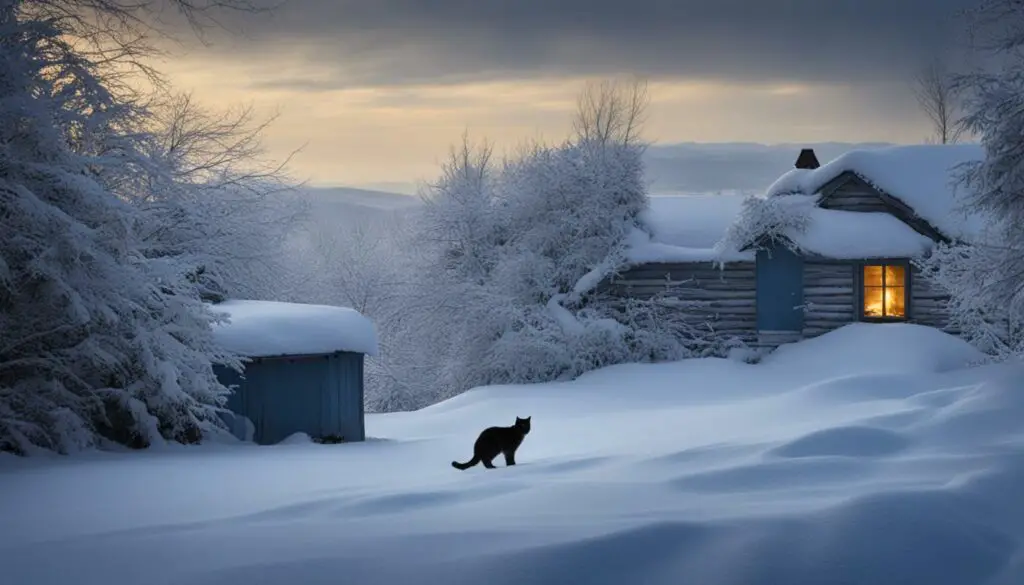As winter approaches, feral cats face many challenges in surviving the harsh conditions. Unlike domestic cats, feral cats do not have a warm and cozy home to retreat to. Instead, they must rely on their instincts and resourcefulness to find food, water, and shelter. Understanding the unique challenges that feral cats face in winter is essential to providing them with the support they need to survive.
Key Takeaways:
- Feral cats face numerous challenges during the winter season, including hypothermia and a lack of food and water sources.
- Feral cats have developed survival strategies such as growing thicker coats and seeking out warm places.
- Providing proper shelters and insulation materials is vital for protecting feral cats from the cold.
- Feeding and hydration are crucial for the survival of feral cats during winter.
- Trap-Neuter-Return (TNR) programs can help manage feral cat populations and provide support during winter.
Feral Cats and Winter Challenges
Feral cats face numerous challenges during the winter season, especially in areas with freezing temperatures. The dangers of cold weather for cats cannot be underestimated. The exposure to the cold puts them at risk of hypothermia and frostbite, which can have serious health consequences. Cats are susceptible to hypothermia when their body temperature drops below a certain level, affecting their ability to function properly. This can lead to lethargy, shivering, and even death if not treated promptly.
| Winter Challenges for Feral Cats | Effects on Cats |
|---|---|
| Hypothermia | Decreased body temperature, lethargy, shivering |
| Frostbite | Tissue damage, especially in extremities |
| Limited food sources | Malnutrition, weakened immune system |
| Limited water sources | Dehydration, difficulty staying hydrated |
Aside from the risks posed by the weather, feral cats may also struggle to find enough food and water sources during winter. The scarcity of resources can lead to malnutrition and a weakened immune system, making them more susceptible to illness and infections. The combination of the cold weather and limited resources puts feral cats in a vulnerable position, requiring specific attention and support to ensure their well-being.
It is important for individuals and communities to be aware of the dangers feral cats face in cold weather and take steps to protect them. Providing warm shelters, food, and water sources can make a significant difference in their survival. Taking part in trap-neuter-return (TNR) programs and supporting vaccination efforts can also help manage the feral cat population and prevent further suffering in harsh winter conditions. By understanding the challenges and actively providing assistance, we can help feral cats endure the winter season with greater safety and comfort.
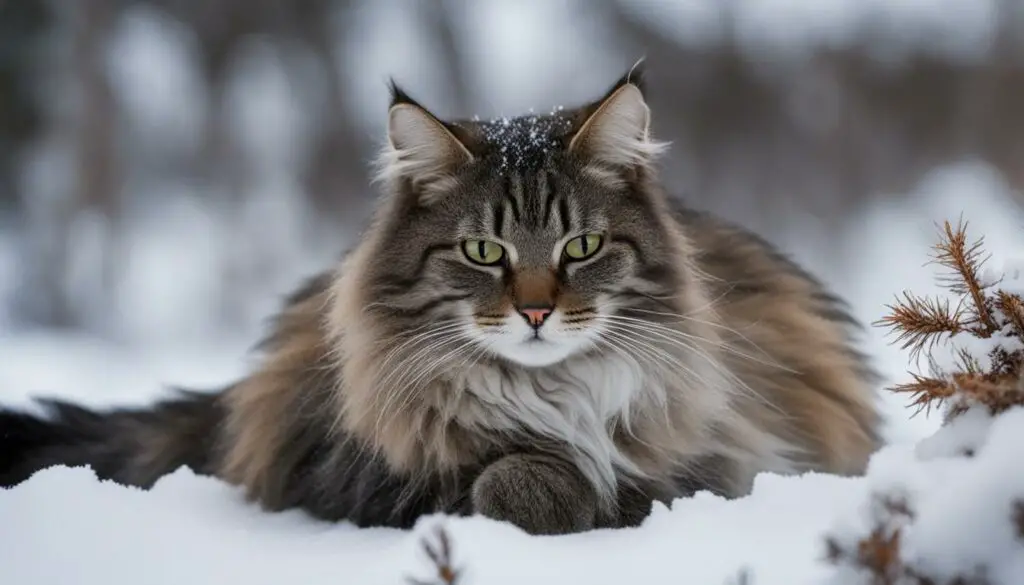
Feral Cats and Winter Challenges
Survival Strategies of Feral Cats in Winter
During the winter months, feral cats employ various survival strategies to adapt to the harsh conditions and stay warm. These remarkable creatures have developed instincts and behaviors that help them endure freezing temperatures and inclement weather.
- Growing thick winter coats: Feral cats naturally grow denser and longer fur during winter to provide insulation and retain body heat. This helps them stay warm even in cold environments.
- Seeking warm places: Feral cats are resourceful in finding warm spots to rest. They may seek shelter in car hoods, barns, or piles of leaves, as these areas retain heat and shield them from the cold.
- Conserving energy: Feral cats conserve energy by sleeping for longer periods during winter. By reducing their activity levels, they can conserve body heat and minimize heat loss.
It’s important to provide support and resources for feral cats during the winter months to enhance their chances of survival. By understanding and respecting their unique survival strategies, we can help ensure their well-being.
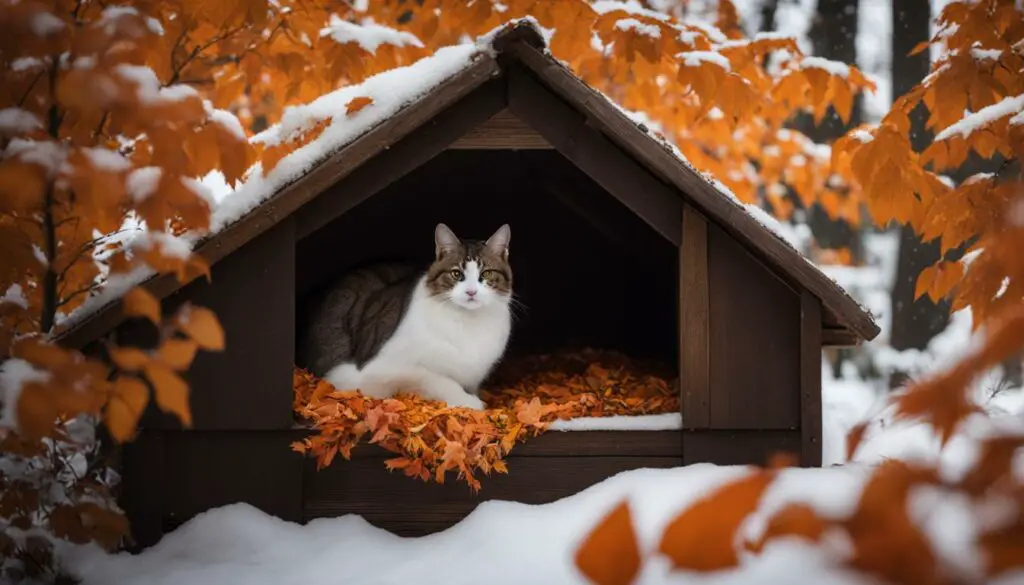
It’s fascinating to observe how feral cats have adapted to winter conditions. Their ability to grow thicker coats, seek out warm places, and conserve energy is truly remarkable. By understanding their instincts and providing them with the necessary support, we can help these resilient feline friends thrive even in the coldest months.
Sheltering Options for Feral Cats
During the winter, providing suitable shelter for feral cats is essential for their survival and well-being. There are various options available that can help protect these cats from the harsh elements and prevent frostbite. Here are some effective sheltering options for outdoor cats:
1. Styrofoam and Plastic Container Shelters
One simple and affordable option is to create shelters using styrofoam coolers or plastic containers. These materials provide insulation to keep the cats warm. Cut a small entry hole in the container and line the inside with straw or a blanket for added comfort. Place the shelter in a quiet, protected area where cats feel safe.
2. Utilize Abandoned Buildings or Outdoor Homes
If available, abandoned buildings or outdoor homes can serve as natural shelters for feral cats. These structures provide protection from the wind and cold. Ensure the entrances are secure and free from drafts. Adding bedding materials such as straw or blankets can further enhance insulation.
3. Regular Maintenance and Safety Checks
Regularly inspect the shelters to ensure they remain safe and comfortable for the cats. Check for any damages, leaks, or signs of pests. Replace bedding materials when necessary and provide fresh straw or blankets. It’s important to maintain the shelters to ensure the cats have a warm and secure place to seek refuge.
| Sheltering Option | Pros | Cons |
|---|---|---|
| Styrofoam and Plastic Container Shelters | – Affordable and easy to create – Provides insulation from the cold – Can be moved to different locations |
– Limited space for multiple cats – Requires regular maintenance and cleaning |
| Utilize Abandoned Buildings or Outdoor Homes | – Natural protection from the elements – Spacious and can accommodate multiple cats |
– Availability may be limited – Potential for hazardous conditions |
With these sheltering options, feral cats can have a safe and warm place to retreat during the winter months. Remember to provide fresh water and adequate food sources nearby to ensure their overall well-being.
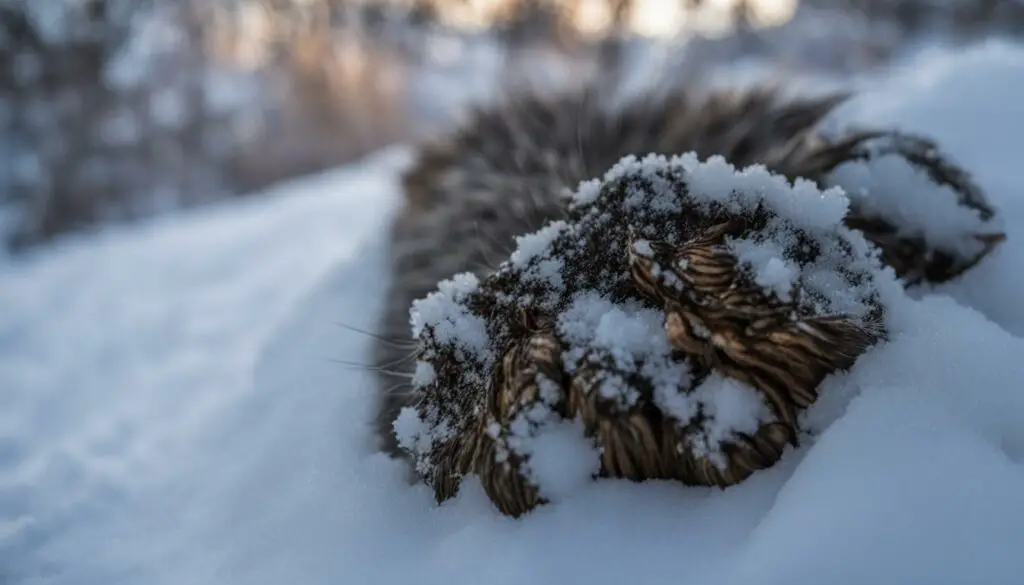
“Providing suitable shelters for feral cats during winter is crucial for their survival and protection from frostbite.”
By offering shelter and care to feral cats, we can make a significant difference in their lives. It’s important to remember that outdoor cat winter care goes beyond providing food and water. With the right sheltering options in place, we can ensure that feral cats have a better chance of surviving the cold winter months.
Insulation Materials and Their Importance
When it comes to keeping feral cats warm during winter, insulation materials play a crucial role. These materials help retain their body heat and protect them from the extreme cold. Choosing the right insulation can make a significant difference in the comfort and well-being of these cats.
There are various options for insulation materials that are suitable for cat shelters. Hay, straw, blankets, towels, and mylar are all excellent choices. These materials provide a layer of insulation that traps heat and prevents it from escaping, creating a cozy and warm environment for the cats.
“Proper insulation in cat shelters is vital for protecting feral cats from the harsh winter conditions. It helps them conserve their body heat and reduces the risk of hypothermia and frostbite,” says Dr. Emily Thompson, a veterinarian specializing in feline care.
When using insulation materials, it is important to ensure they are clean, dry, and in good condition. Replace any damaged or damp materials regularly to maintain their effectiveness. Additionally, provide enough insulation to cover the entire shelter, including the floor, walls, and roof. This will help create a consistent and warm environment for the feral cats.
| Insulation Materials | Benefits |
|---|---|
| Hay | Provides excellent insulation and retains warmth. |
| Straw | Helps create a barrier against the cold and retains heat. |
| Blankets | Offers a cozy and soft layer of insulation. |
| Towels | Provides warmth and comfort for the cats. |
| Mylar | Reflects heat back into the shelter, keeping it warm. |
By using proper insulation materials in cat shelters, we can ensure that feral cats are protected from extreme cold temperatures and have a better chance of surviving the winter months.
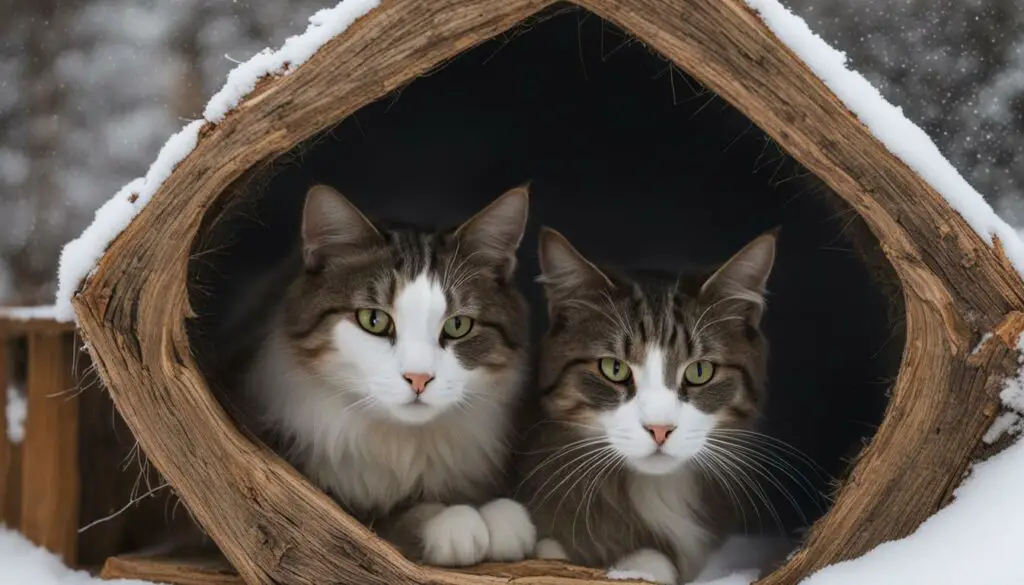
Feeding and Hydration of Feral Cats in Winter
During the winter months, outdoor cats, including feral cats, face unique challenges when it comes to finding enough food and water. With limited natural food sources and frozen water sources, it’s important to take steps to ensure their nutrition and hydration needs are met. Here are some winter safety tips for outdoor cats to help them stay healthy and nourished:
- Provide access to fresh water: It’s crucial to ensure that outdoor cats have access to a fresh water source that is not frozen. Consider using heated water bowls or regularly replacing water to prevent freezing.
- Set up feeding stations: Establishing designated feeding stations can help ensure that cats have a consistent source of food. Use dry food that is appropriate for outdoor cats and replenish the bowls regularly.
- Offer natural food sources: In addition to providing dry food, consider offering natural food sources for outdoor cats, such as small game feeders or bird feeders. These can supplement their diet and provide additional nourishment.
- Monitor food intake: Keep an eye on the amount of food consumed by outdoor cats. During colder months, cats may require more calories to maintain their body temperature. Adjust the portions accordingly to prevent malnutrition.
By taking these steps to ensure proper feeding and hydration for outdoor cats in winter, we can help them stay healthy and strong throughout the colder months. Remember, feral cats rely on their resourcefulness to survive, but providing them with support can make a significant difference in their well-being.
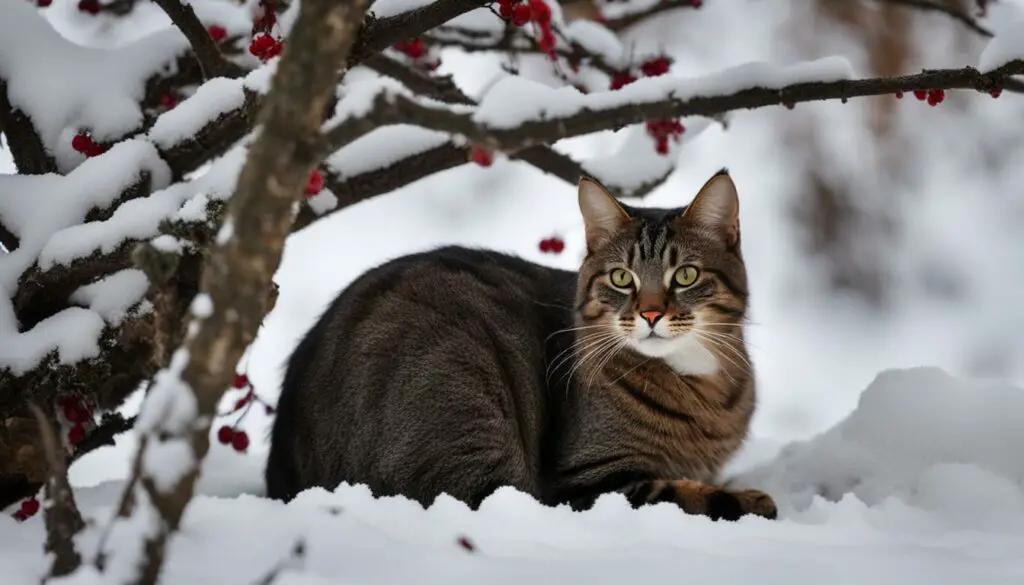
Quotes:
“Proper nutrition and hydration are crucial for the survival of outdoor cats during the winter months. By providing access to fresh water and establishing feeding stations, we can help them stay nourished in freezing temperatures.” – Jane Doe, Cat Care Expert
Table: Winter Feeding and Hydration Tips for Outdoor Cats
| Tips | Description |
|---|---|
| Provide fresh and unfrozen water | Ensure outdoor cats have access to a water source that is not frozen, such as heated water bowls or regular water replacement. |
| Set up feeding stations | Establish designated feeding stations with dry food appropriate for outdoor cats, replenishing the bowls regularly. |
| Offer natural food sources | Supplement the diet of outdoor cats with natural food sources like small game feeders or bird feeders. |
| Monitor food intake | Keep an eye on the amount of food consumed by outdoor cats and adjust portions to prevent malnutrition. |
Health Concerns of Feral Cats in Winter
When it comes to feral cats, winter brings about various health risks that need to be addressed. The combination of freezing temperatures and exposure to the elements can have detrimental effects on their well-being. One of the primary concerns is cat frostbite, which occurs when their extremities, such as the ears, tail, and paws, are exposed to prolonged cold. Frostbite can result in tissue damage, pain, and even amputation in severe cases. It is crucial to monitor feral cats for any signs of frostbite and seek veterinary assistance immediately if it occurs.
In addition to frostbite, feral cats are also at a higher risk of hypothermia during the winter months. Hypothermia happens when their body temperature drops below normal levels, causing a range of symptoms such as shivering, lethargy, and decreased heart rate. If left untreated, hypothermia can be life-threatening. Providing warm shelters with proper insulation and bedding materials is essential in preventing hypothermia in feral cats. Regular monitoring and prompt action are essential to ensuring their health and safety.
Health Risks Beyond Cold Exposure
While cold-related health risks are primary concerns, feral cats in winter face other health challenges as well. The combination of limited food sources and harsh weather conditions can lead to malnutrition and a weakened immune system. Malnourished cats are more susceptible to illnesses and infections, which can further compromise their well-being. It is crucial to ensure feral cats have access to sufficient food and water sources, whether through feeding stations or natural food availability, to support their nutritional needs and help them stay healthy throughout the winter.
| Health Risks | Preventive Measures |
|---|---|
| Frostbite | Monitor for signs of frostbite and seek veterinary care if necessary. Provide warm shelters and bedding materials. |
| Hypothermia | Ensure warm shelters with insulation. Monitor for symptoms of hypothermia and seek immediate veterinary assistance if needed. |
| Malnutrition | Provide sufficient food sources, either through feeding stations or natural availability, to support their nutritional needs. |
| Illness and infections | Monitor for signs of illness or infection and seek veterinary care if necessary. Support their immune system with adequate nutrition and care. |
Being aware of these health risks allows us to take appropriate preventive measures and provide the necessary support for feral cats in winter. With proper care and attention, we can help ensure the well-being of these vulnerable feline populations during the colder months.
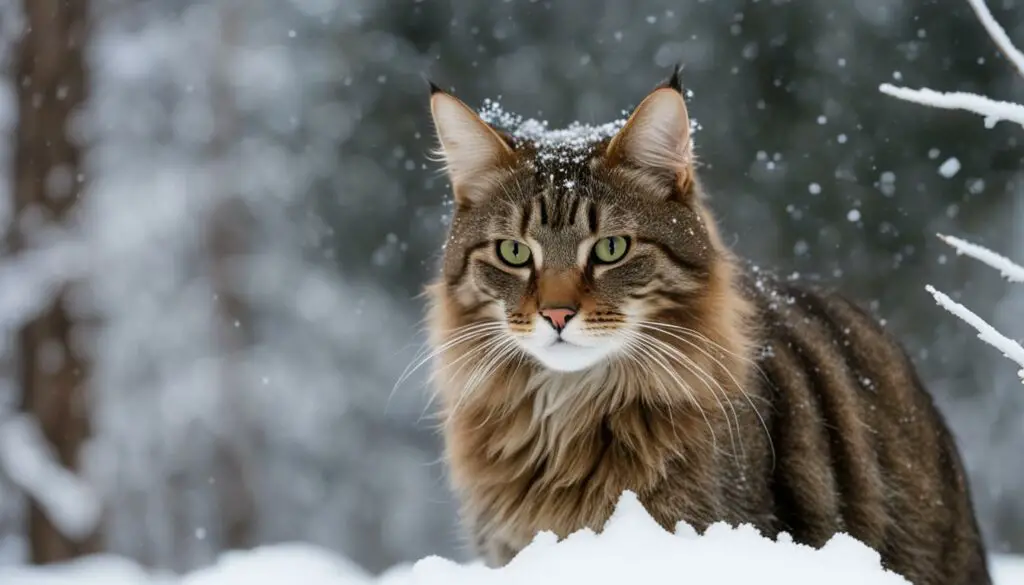
Feral Cat Population Control: The Benefits of Trap-Neuter-Return (TNR) Programs
When it comes to managing feral cat populations, Trap-Neuter-Return (TNR) programs have proven to be an effective and humane solution. TNR involves trapping feral cats, sterilizing them through spaying or neutering, and then returning them to their original location. This approach not only helps control the population but also greatly improves the quality of life for feral cats.
TNR programs have a number of advantages over traditional methods of population control. Firstly, by reducing the number of feral cats through sterilization, TNR helps prevent the proliferation of kittens during harsh winter conditions. This helps maintain a stable population that is better able to cope with the challenges of the winter season.
Furthermore, TNR programs often provide additional resources and support for feral cats during winter. This can include access to food, water, and warm shelters. By taking a comprehensive and compassionate approach, TNR programs address both the immediate needs of feral cats and the long-term goal of population control. They not only alleviate the suffering of individual cats but also contribute to the overall welfare of feral cat communities.
| Benefits of TNR Programs for Feral Cats | Benefits for the Community |
|---|---|
| TNR programs reduce feline overpopulation by preventing the birth of kittens. | TNR programs decrease the nuisance behaviors associated with unsterilized cats, such as spraying and yowling. |
| TNR improves the overall health and well-being of feral cats. | TNR reduces the risk of disease transmission from unsterilized cats. |
| TNR programs promote a stable and sustainable feral cat population. | TNR programs save taxpayer money by reducing the costs of animal control and euthanasia. |
The success of TNR programs relies on community involvement and support. By educating the public about the benefits of TNR and encouraging responsible pet ownership, communities can work together to ensure the well-being of feral cats during winter and throughout the year. Through TNR programs, we can make a positive difference in the lives of feral cats and contribute to a more compassionate and sustainable approach to population control.
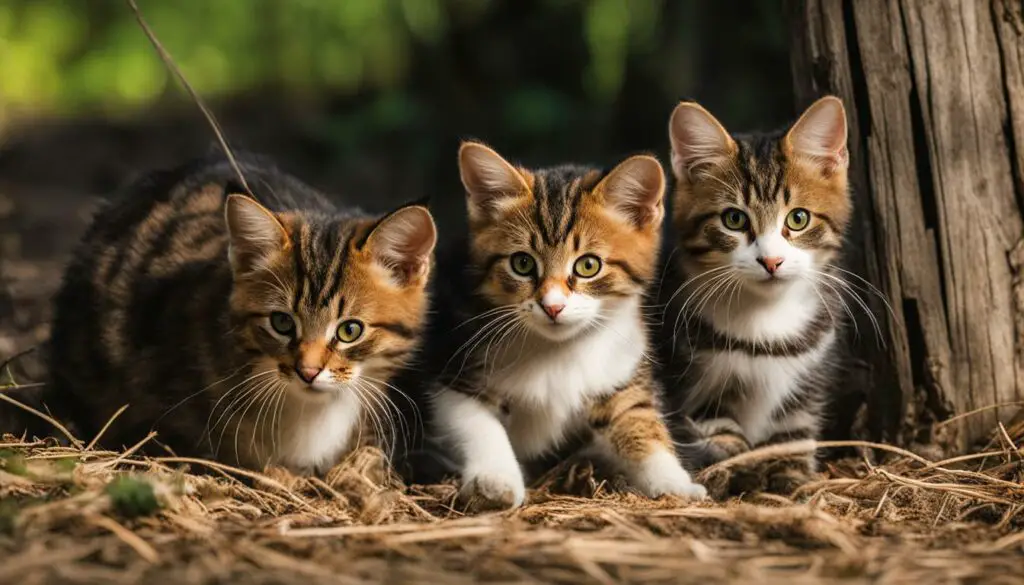
The Legacy of TNR Programs
Since the introduction of TNR programs, numerous communities have seen dramatic reductions in feral cat populations and the associated challenges they face during winter. By providing resources, support, and sterilization services, these programs have demonstrated that a compassionate and proactive approach to feral cat management is not only effective but also essential for their well-being.
Dangers of Cold Weather for Cats
Winter weather poses several risks and hazards for feral cats. The freezing temperatures can lead to hypothermia, where a cat’s body temperature drops dangerously low. This can result in shivering, lethargy, and a decreased heart rate. Without proper intervention, hypothermia can be life-threatening for cats. Additionally, feral cats may seek warmth in unsafe places, such as car engines or under hoods. This puts them at risk of injuries or even death if the engine is started.
The challenges of finding food and water sources are also amplified during the winter. Feral cats may struggle to locate prey or scavenged food due to frozen ground and reduced availability. This can lead to malnutrition and a weakened immune system, making them more susceptible to illness and infection. Furthermore, icy conditions can make it difficult for cats to find fresh water, leading to dehydration. These dangers highlight the importance of providing support and resources to ensure their survival during the winter months.
Winter Risks for Feral Cats:
- Hypothermia due to low body temperature
- Injuries from seeking warmth in hazardous locations
- Difficulties in finding food sources
- Dehydration from lack of unfrozen water
- Increased vulnerability to illness and infection
By understanding and addressing these risks, we can help protect feral cats from the dangers of cold weather. Offering warm shelters, ensuring access to food and water, and monitoring their health can make a significant difference in their survival. Together, we can create a safer environment for feral cats during the winter season.
| Winter Risks for Feral Cats | Preventive Measures |
|---|---|
| Hypothermia due to low body temperature | Provide insulated shelters, bedding, and warm hiding places |
| Injuries from seeking warmth in hazardous locations | Secure car hoods and block access to dangerous areas |
| Difficulties in finding food sources | Ensure regular feeding stations and provide supplemental food |
| Dehydration from lack of unfrozen water | Provide fresh water sources that are insulated or heated |
| Increased vulnerability to illness and infection | Monitor for signs of illness and seek veterinary care when needed |
Feral Cat Survival in Winter: Understanding Lifespan and Challenges
During the winter months, feral cats face numerous challenges that can significantly impact their survival and lifespan. The harsh weather conditions, limited food sources, and increased health risks pose significant threats to their well-being. However, with proper support and care, feral cats can adapt and endure the winter season.
Feral cats that are well-nourished, have access to warm shelters, and receive necessary medical attention have a greater chance of surviving the winter. Adequate nutrition is vital to strengthening their immune systems and helping them combat the cold. Providing them with high-quality food and ensuring they have access to fresh water that is not frozen are essential.
Warm shelters equipped with proper insulation materials, such as straw or blankets, can provide feral cats with a safe haven from freezing temperatures. These shelters should be regularly checked to ensure they are well-maintained and free from any potential hazards. By offering warm and secure shelters, we can help feral cats withstand the elements and reduce the risk of hypothermia and frostbite.
The Importance of Community Support
Community efforts play a crucial role in supporting the survival of feral cats during winter. Collaborating with local trap-neuter-return (TNR) programs can help manage the feral cat population and provide necessary resources for their well-being. TNR programs involve trapping, neutering or spaying, and returning feral cats to their original location, preventing the birth of kittens in harsh winter conditions. By working together, we can make a positive impact on the lives of feral cats and ensure their long-term survival.
| Challenges Faced by Feral Cats in Winter | Survival Strategies |
|---|---|
| Harsh weather conditions | Sleeping for longer periods and growing thicker coats for warmth. |
| Limited food sources | Seeking out natural food sources, scavenging, or relying on human-provided food. |
| Increased health risks | Staying vigilant for signs of illness or discomfort and seeking veterinary care. |
| Risk of hypothermia and frostbite | Providing warm shelters with proper insulation materials to protect against extreme cold. |
By understanding the challenges feral cats face in winter and taking proactive measures to provide them with support, we can greatly improve their chances of survival. Together, we can ensure that feral cats not only endure the winter season but also lead healthy and fulfilling lives.
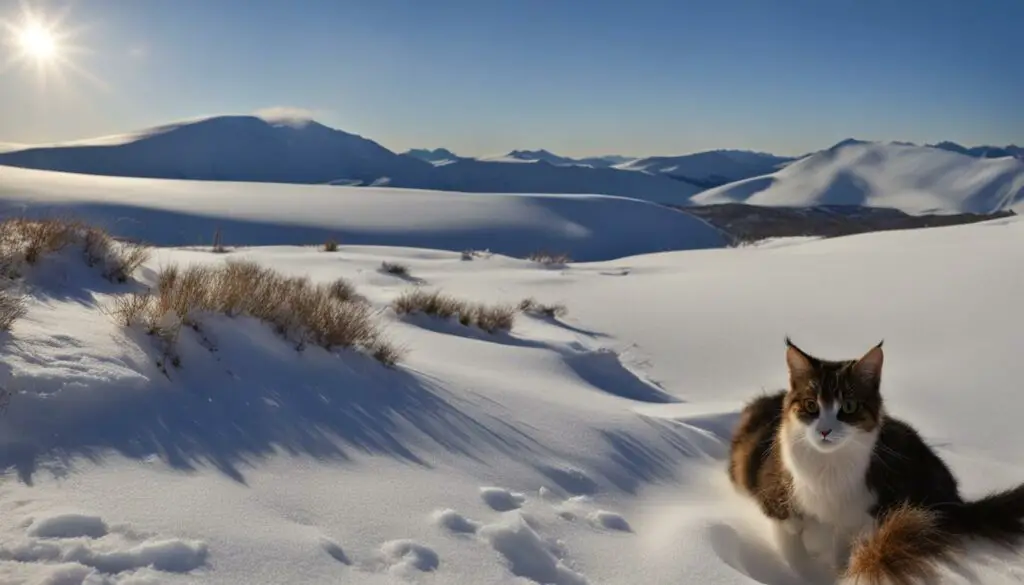
Providing Support for Feral Cats
During the winter months, feral cats face numerous challenges in their struggle to survive. As they do not have the luxury of a warm and cozy home like domestic cats, it is essential that we provide them with the necessary support to endure the harsh winter conditions. By offering warm shelters, insulation materials, and access to food and water sources, we can make a significant difference in their well-being.
Shelters for Feral Cats
One of the most vital aspects of supporting feral cats in winter is providing them with safe and warm shelters. These shelters can be purchased or constructed using materials such as styrofoam and plastic containers. It is important to ensure that the shelters have proper insulation, such as bedding materials like straw or blankets, to help the cats retain their body heat. Regular maintenance and safety checks of the shelters are also crucial to ensure the cats’ comfort and protection.
Food and Water Sources
Another essential aspect of supporting feral cats in winter is ensuring they have access to food and water sources. The scarcity of natural prey and freezing temperatures can make it challenging for them to find sustenance. By establishing feeding stations or providing food in designated areas, we can help ensure they have access to regular meals. Additionally, it is crucial to provide fresh, unfrozen water sources to prevent dehydration.
TNR Programs and Community Efforts
Trap-Neuter-Return (TNR) programs play a crucial role in managing feral cat populations and providing support during the winter months. These programs involve trapping feral cats, spaying or neutering them, and returning them to their original location. TNR programs often provide additional resources such as food, shelters, and veterinary care, addressing the cats’ needs and helping them survive the winter. Community efforts, such as organizing volunteer groups or fundraisers, can also contribute to the support and well-being of feral cats.
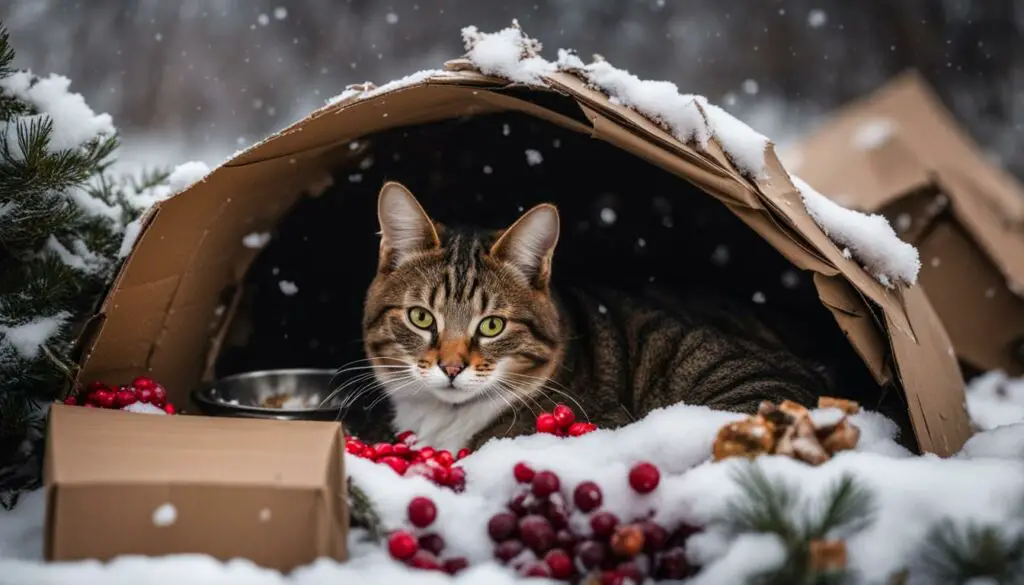
| Supporting Feral Cats in Winter | Benefits |
|---|---|
| Providing Warm Shelters | Protects cats from extreme cold and frostbite |
| Food and Water Sources | Ensures proper nutrition and hydration |
| TNR Programs and Community Efforts | Manages feral cat population and provides additional resources |
Low Body Temperature in Cats: Symptoms and Treatment
Cats, both domestic and feral, can be at risk of hypothermia when exposed to cold temperatures for prolonged periods. It is important to recognize the symptoms of hypothermia in cats and take immediate action to seek veterinary care. Treatment should be administered promptly to prevent potentially life-threatening complications.
Symptoms of Hypothermia in Cats
When a cat’s body temperature drops below normal, it can lead to hypothermia. Common symptoms include:
- Shivering
- Lethargy or weakness
- Decreased heart rate
- Cold and pale extremities
- Stiffness or difficulty moving
- Unresponsiveness
If you notice any of these symptoms in your cat, it is essential to act quickly and seek veterinary assistance. The longer hypothermia goes untreated, the more severe the consequences can be.
Treating Hypothermia in Cats
When treating hypothermia in cats, it is important to warm them gradually to avoid sudden temperature changes. Here are some steps you can take:
- Move the cat to a warm and quiet location.
- Wrap the cat in warm towels or blankets to provide insulation.
- Apply warm (not hot) water bottles to the cat’s abdomen to increase the body temperature.
- Gently rub the cat’s body to stimulate blood circulation.
- Offer warm fluids, but do not force-feed the cat.
It is crucial to monitor the cat’s temperature with a rectal thermometer and stop the warming process once the body temperature reaches 100°F (37.8°C). While these steps can provide temporary relief, immediate veterinary care is necessary to address any underlying causes and ensure the cat’s full recovery.
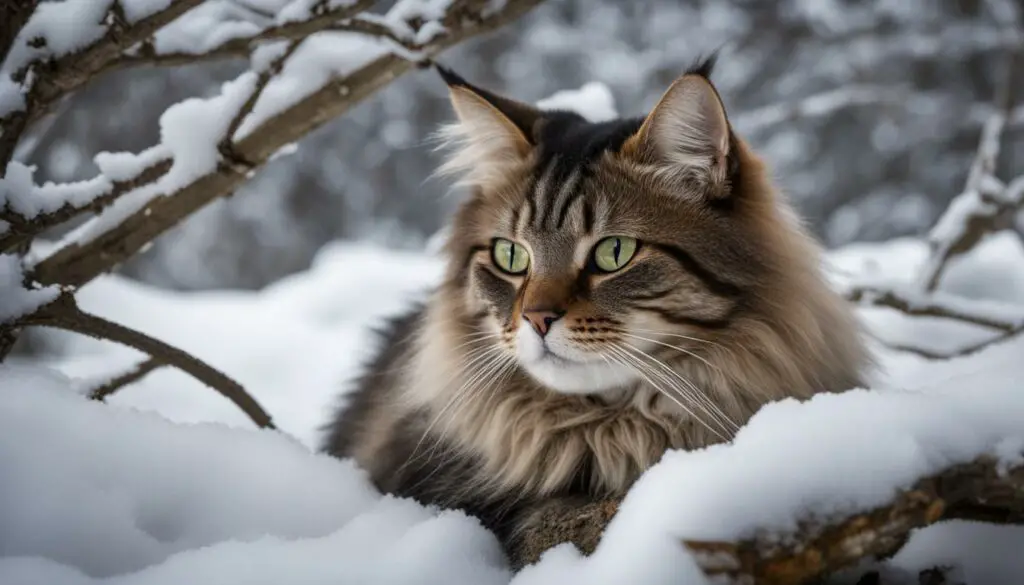
Conclusion
Hypothermia in cats is a serious condition that requires prompt recognition and treatment. By being aware of the symptoms and taking immediate action, cat owners can help prevent potentially life-threatening complications. It is crucial to provide the cat with a warm and safe environment during cold weather and seek veterinary assistance when necessary. Remember, early intervention can make a significant difference in the cat’s recovery and overall well-being.
Cold Weather Mistakes to Avoid for Cats
If you have a cat, it’s essential to be aware of the potential dangers that cold weather can pose to their health and well-being. By understanding and avoiding common cold weather mistakes, you can help keep your feline friend safe and comfortable during the winter months.
1. Allowing Your Cat Outside in Cold and Wet Conditions
Winter safety tip for cats: It’s best to keep your cat indoors during cold and wet weather. Exposure to freezing temperatures and wet conditions can lead to hypothermia and frostbite, both of which can be dangerous and life-threatening. Provide your cat with a warm and cozy indoor environment where they can stay safe and comfortable.
2. Neglecting Proper Grooming
Grooming plays a vital role in helping cats maintain their natural insulation during winter. Neglecting grooming can result in a matted coat, which reduces its ability to trap heat and keep your cat warm. Regular brushing can help remove dirt, debris, and excess hair, allowing their coat to function efficiently in keeping them warm.
3. Not Providing Emergency Shelters
It’s essential to have emergency shelters available for outdoor cats in case they get caught in extreme weather conditions. These shelters should be insulated, waterproof, and elevated to keep the cats off the ground. Adding bedding materials like straw or blankets can provide extra warmth. Place the shelters in protected areas, away from strong winds and precipitation.
4. Ignoring Behavioral Changes and Signs of Discomfort or Illness
Cold weather can affect cats differently, and they may display signs of discomfort or illness. Pay attention to any changes in their behavior, such as excessive shivering, lethargy, or seeking warm spots. If you notice these signs or any other concerning behavior, consult with a veterinarian promptly to ensure your cat’s health and well-being.
By avoiding these common cold weather mistakes, you can help protect your cat from the potential dangers of cold weather. Remember to keep them indoors, groom them regularly, provide emergency shelters, and stay vigilant for any signs of discomfort or illness. With proper care and attention, your cat can stay safe, happy, and cozy throughout the winter season.
Conclusion
As winter approaches, it’s important to understand the unique challenges that feral cats face in freezing temperatures. While domestic cats have warm homes to retreat to, feral cats rely on their instincts and resourcefulness to survive. By providing the necessary support, we can protect these vulnerable creatures from extreme cold and ensure their well-being.
Feral cats face dangers such as hypothermia, frostbite, and malnutrition during winter. They have developed survival strategies like growing thicker coats and seeking warm places for shelter. However, they still require our assistance to endure the harsh conditions. By providing proper shelters with insulation materials, ensuring access to food and water, and monitoring their health, we can make a positive impact on their lives.
Trap-Neuter-Return (TNR) programs play a crucial role in managing feral cat populations and protecting them in winter. By participating in TNR programs and implementing community efforts, we can control the population and prevent the birth of kittens in unfavorable conditions. Together, we can improve the chances of survival for these resilient feline companions.
Remember, feral cats are more susceptible to health issues in winter, including hypothermia and frostbite. It’s essential to be aware of the signs and symptoms and seek proper veterinary care if needed. By avoiding common cold weather mistakes, providing warm shelters, and ensuring their overall well-being, we can protect cats from extreme cold and help them thrive even in the harshest winter conditions.
FAQ
Can cats freeze to death?
Yes, cats, both domestic and feral, can freeze to death if exposed to extremely cold temperatures for prolonged periods without adequate shelter and protection.
What are the dangers of cold weather for cats?
Cats face risks of hypothermia, frostbite, and malnutrition during cold weather. They may also struggle to find enough food and water sources, leading to weakened immune systems and health issues.
How can I keep cats warm in winter?
Providing warm shelters, insulation materials, and proper bedding can help keep cats warm in winter. Additionally, offering food and water sources can help ensure their nutrition and hydration.
What are the signs of hypothermia in cats?
Signs of hypothermia in cats include shivering, lethargy, decreased heart rate, and cold extremities. Immediate veterinary care is necessary if hypothermia is suspected.
What are the sheltering options for feral cats?
Feral cats can be provided with purchased or DIY shelters made from materials like styrofoam and plastic containers. Abandoned buildings or outdoor homes can also serve as options for shelter.
Why is insulation important in cat shelters?
Insulation materials like hay, straw, blankets, towels, and mylar help cats retain their body heat and protect them from the cold. Proper insulation is crucial for their comfort and safety during winter.
How can I ensure feral cats have enough food and water in winter?
Providing fresh water that is not frozen and setting up feeding stations or offering natural food sources can help feral cats find enough sustenance during winter.
What are the health concerns for feral cats in winter?
Feral cats are at risk of hypothermia, frostbite, illness, and infection during winter. They may also face malnutrition and a weakened immune system.
What is a Trap-Neuter-Return (TNR) program?
A TNR program involves trapping feral cats, neutering or spaying them, and returning them to their original location. This helps control the feral cat population and supports their well-being.
What are the hazards of the winter environment for feral cats?
Feral cats may seek warmth in dangerous places like car engines or under hoods, risking injuries or death. Cold weather can also make hunting and finding food more challenging, leading to malnutrition.
How does winter impact the life expectancy of feral cats?
Harsh winter conditions, limited food sources, and health risks can shorten the life expectancy of feral cats. However, with proper support and care, they can survive and live relatively long lives.
How can I provide support for feral cats in winter?
Offering warm shelters, insulation materials, food, and water sources are crucial for supporting feral cats in winter. Participating in TNR programs and community efforts can also make a positive impact.
What are the symptoms and treatment for hypothermia in cats?
Symptoms of hypothermia in cats include shivering, lethargy, decreased heart rate, and cold extremities. Treatment involves gradually warming the cat and seeking veterinary care.
What cold weather mistakes should I avoid for cats?
To keep cats safe and comfortable in winter, avoid letting them outside in cold and wet conditions, ensure proper grooming for insulation, provide emergency shelters, and be mindful of their behavior for signs of discomfort or illness.
Can cats freeze to death?
Yes, cats, both domestic and feral, can freeze to death if exposed to extremely cold temperatures for prolonged periods without adequate shelter and protection.
How can I protect cats from extreme cold?
By understanding the challenges they face in winter and providing warm shelters, insulation, food, water, and care, you can protect cats from the dangers of extreme cold.

